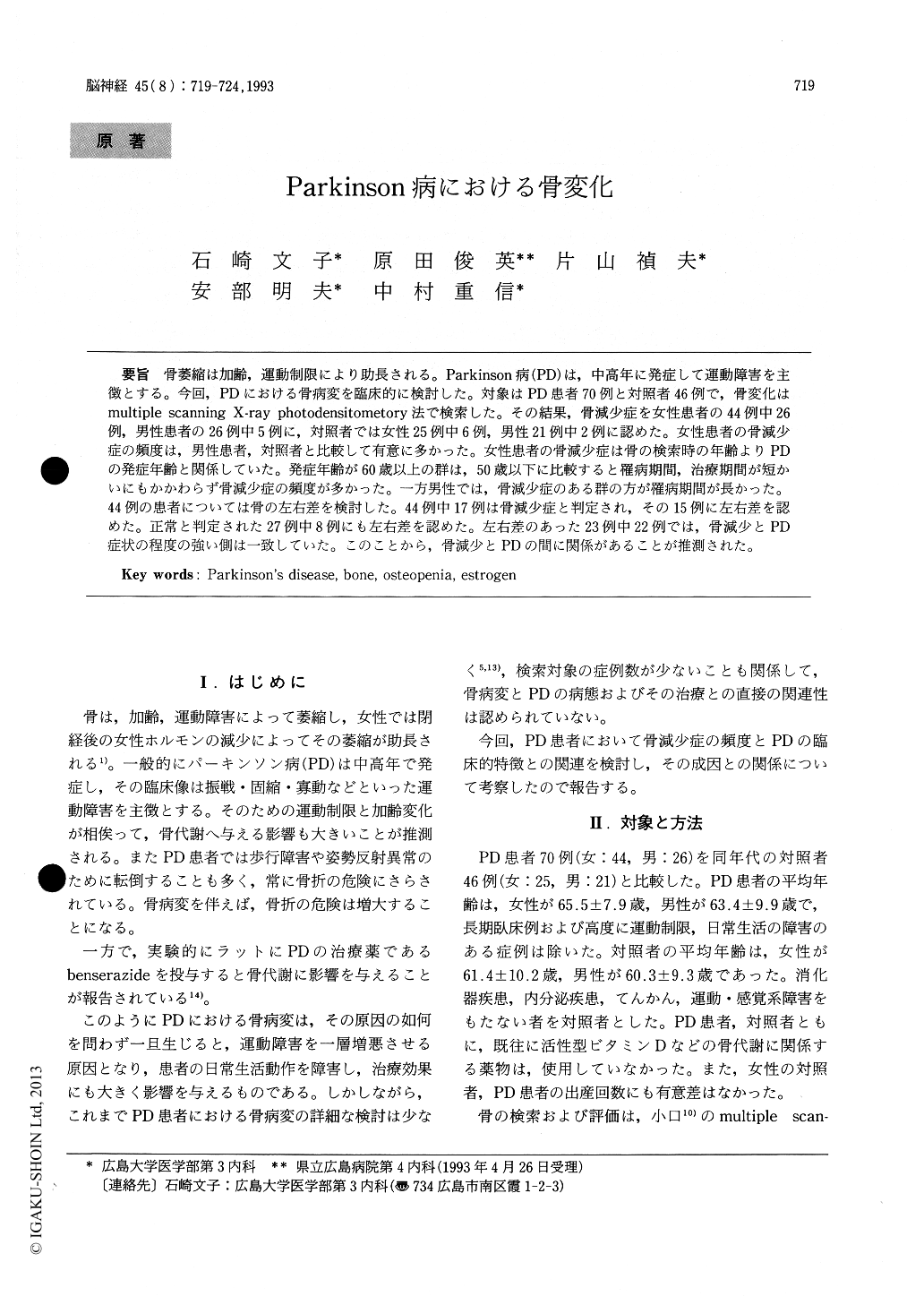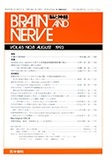Japanese
English
- 有料閲覧
- Abstract 文献概要
- 1ページ目 Look Inside
骨萎縮は加齢,運動制限により助長される。Parkinson病(PD)は,中高年に発症して運動障害を主徴とする。今回,PDにおける骨病変を臨床的に検討した。対象はPD患者70例と対照者46例で,骨変化はmultiple scanning X-ray photodensitometory法で検索した。その結果,骨減少症を女性患者の44例中26例,男性患者の26例中5例に,対照者では女性25例中6例,男性21例中2例に認めた。女性患者の骨減少症の頻度は,男性患者,対照者と比較して有意に多かった。女性患者の骨減少症は骨の検索時の年齢よりPDの発症年齢と関係していた。発症年齢が60歳以上の群は,50歳以下に比較すると罹病期間,治療期間が短かいにもかかわらず骨減少症の頻度が多かった。一方男性では,骨減少症のある群の方が罹病期間が長かった。44例の患者については骨の左右差を検討した。44例中17例は骨減少症と判定され,その15例に左右差を認めた。正常と判定された27例中8例にも左右差を認めた。左右差のあった23例中22例では,骨減少とPD症状の程度の強い側は一致していた。このことから,骨減少とPDの間に関係があることが推測された。
Parkinson's disease (PD) is a movement disorder and tends to occur in elderly people, who sometimes develop age-related osteoporosis. Pathological bone changes seem to affect the outcome and prog-nosis of PD. We studied the relationship between bone changes and PD. Bone examination was con-ducted by multiple scanning X-ray photoden-sitometry in 70 patients with PD and 46 age-mat-ched controls. We then compared the results with the clinical characteristics of PD. Of the 70 patients, 44 were women and 26 were men ; the mean ages were 65.5±7.9 (mean±SD) and 63.4±9.9 years, respectively. Of the 46 controls, 25 were women and 21 were men,with mean ages of 61.4ア10.2 and 60.3ア 9.3 years, respectively. Osteopenia was detected in 26 (59 %) of the 44 female, and 5 (19%) of the 26 male patients, and in 6 (24%) of the 25 female and 2 (9%) of the 21 male controls. The frequency of osteopenia was significantly greater in the female patients than in the male patients or the female controls. The mean Hoehn & Yahr stage of female patients with osteopenia was more severe than that of those without osteopenia, with a significant dif-ference between the two groups. Osteopenia in menwas related to the duration of PD, but this was not so in the women. The female patients without osteopenia tended to have earlier onset of PD and longer duration of the disease and treatment. Shor-ter duration of PD and increased incidence of osteopenia were shown in the group with onset in the seventh decade compared to those with onset prior to the sixth decades. In the men, there was no relationship between severity of PD and osteopenia. In 23 of 44 PD patients, both hands were analyzed with respect to lateralization of bone changes and side-related differences were noted. Fifteen of 17 patients with osteopenia showed asymmetrical bone changes. In 15 patients, the side on which PD symptoms were more severe coincided with the side with more marked osteopenia, suggesting that osteopenia is related to the pathophysiology of PD. No significant correlation between signs and symp-toms of PD at the time of bone examination and osteopenia was shown. Consequently, osteopenia was demonstrated in PD patients, especially in women with onset of PD when they were older than 60 years. Further study of bone in PD is important for the prevention of disability induced by bone fractures.

Copyright © 1993, Igaku-Shoin Ltd. All rights reserved.


